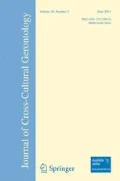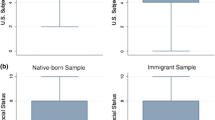Abstract
Despite widespread use of measures of social status and increasing interest in the relationship between social status and health, the variables used to denote social status are often inappropriate for use with older populations. This article examines responses to a recently developed measure of subjective social position, known as the MacArthur Scale of Subjective Social Status. The instrument asks respondents to use ten rungs of a ladder to position themselves socioeconomically relative to other people in their country and, separately, in their community. These questions were incorporated into a recent national survey of middle-aged and older adults in Taiwan. The objectives of the analysis were to gain a better understanding of how such subjective assessments are formed (i.e., to explore the contribution of social, economic, and cultural factors in the determination of position within a social hierarchy) and to assess the potential utility of the ladder instrument in social science and health research. This article compares results from Taiwan with those derived from subjective measures of social status in Western populations. The findings support use of the MacArthur Scale of Subjective Social Status as a measure of subjective social status among the older population and suggest that using it may provide further insights into the social gradient in health.



Similar content being viewed by others
Notes
This estimate is based on an average conversion rate of NT$ 31 to 1 USD for the period 1999–2000.
The Spearman rank correlation between the two ladders was 0.61 for mothers of the adolescents, compared with 0.35 for the adolescents themselves (Goodman et al., 2001). Both groups of respondents were given the same ladder question pertaining to US society, but the second question pertained to the school community for adolescents and to the community (as defined by the respondent) for adults.
For example, in a simple regression model that included only age (as a continuous variable) and gender, a 20-year difference in age was associated with a difference of only 0.17-rung for Taiwan and 0.30-rung for the community. Because the 2000 Social Environment and Biomarkers of Aging Study was limited to persons aged 54 and older, the analysis included only individuals born in 1946 or earlier. With the availability of future waves of this survey, we will be able to determine whether the inclusion of more recent cohorts results in larger age effects.
References
Adler, N. E., Epel, E. S., Castellazzo, G., & Ickovics, J. R. (2000). Relationship of subjective and objective social status with psychological and physical health: Preliminary data in healthy white women. Health Psychology, 19, 585–591.
Adler, N. E., & Ostrove, J. M. (1999). Socioeconomic status and health: What we know and what we don’t. Annals of the New York Academy of Sciences, 896, 3–15.
Baker, H. D. R. (1979). Chinese family and kinship. New York: Columbia University Press.
Baxter, J. (1994). Is husband’s class enough? Class location and class identity in the United States, Sweden, Norway, and Australia. American Sociological Review, 59, 200–235.
Cantril, H. (1965). The pattern of human concerns. Piscataway, NJ: Rutgers University Press.
Centers, R. (1949). The psychology of social classes: A study of class consciousness. Princeton, NJ: Princeton University Press.
Chao, P. (1983). Chinese kinship. London: Kegan Paul International.
Chu, J. J. (1996). Taiwan: A fragmented ‘middle’ class in the making. In R. Robison & D. S. G. Goodman (Eds.), The new rich in Asia (pp. 205–2220). London: Routledge.
Copper, J. F. (2003). Taiwan: Nation-state or province? (4th ed.) Boulder, CO: Westview.
Cornman, J. C., Goldman, N., Weinstein, W., & Chang, M.-C. (2003). Social ties and perceived support: Two dimensions of social relationships and health among the elderly in Taiwan. Journal of Aging and Health, 15, 616–644.
Crittenden, K. S. (1991). Asian self-effacement or feminine modesty? Attributional patterns of women university students in Taiwan. Gender and Society, 5, 98–117.
Davis, N. J. & Robinson, R. V. (1988). Class identification of men and women in the 1970s and 1980s. American Sociological Review, 53, 103–112.
Diamond, N. (1973). The status of women in Taiwan: One step forward, and two steps back. In M. B. Young (Ed.), Women in China: Studies in social change and feminism (pp. 211–242). Ann Arbor: Center for Chinese Studies, University of Michigan.
Duncan, O. D. (1961). A socioeconomic index for all occupations. In A. J. Reiss (Ed.), Occupations and social status (pp. 109–138). New York: Free.
Ekehammar, B., Sidanius, J., & Nilsson, I. (1987). Social status: Construct and external validity. Journal of Social Psychology, 127, 473–481.
Evans, M. D. R., Kelley, J., & Kolosi, T. (1992). Images of class: Public perceptions in Hungary and Australia. American Sociological Review, 57, 461–482.
Featherman, D. L., & Stevens, G. (1982). A revised socio-economic index of occupational status: Application in analysis of sex differences in attainment. In R. M. Hauser, D. Mechanic, A. O. Haller, & T. S. Hauser (Eds.), Social structure and behavior (pp. 141–181). Boston: Academic.
Fricke, T. E., Chang, J. S., & Yang, L. S. (1994). Historical and ethnographic perspectives on the Chinese family. In A. Thornton & H. S. Lin (Eds.), Social change and the family in Taiwan (pp. 22–48). Chicago: University of Chicago Press.
Gates, H. (1981). Ethnicity and social class. In E. M. Ahern & H. Gates (Eds.), The anthropology of Taiwanese society (pp. 241–281). Palo Alto, CA: Stanford University Press.
Goldman, N. (2001). Social inequalities in health: Disentangling the underlying mechanisms. Annals of the New York Academy of Sciences, 954, 118–139.
Goldman, N., Glei, D., & Chang, M. C. (2003). The role of clinical risk factors in understanding self-rated health. Journal of Clinical Epidemiology, 56, 148–154.
Goodman, E., Adler, N. E., Kawachi, I., Frazier, A. L., Huang, B., & Colditz, G. A. (2001). Adolescents’ perceptions of social status: Development and evaluation of a new indicator. Pediatrics, 108, E31.
Goyder, J. C. (1975). A note on the declining relation between subjective and objective class measures. British Journal of Sociology, 26, 102–109.
Greenhalgh, S. (1984). Networks and their nodes: Urban society in Taiwan. China Quarterly, 99, 529–552.
Grundy, E., & Holt, G. (2001). The socioeconomic status of older adults: How should we measure it in studies of health inequalities? Journal of Epidemiology and Community Health, 55, 895–904.
Hermalin, A. I., Chang, M. C., & Road, C. (2002). Economic well-being: Insights from multiple measures of income and assets. In A. I. Hermalin (Ed.), The well-being of the elderly in Asia: A four-country comparative study (pp. 295–360). Ann Arbor: University of Michigan Press.
Hermalin, A. I., Liu, P. K. C., & Freedman, D. S. (1994). The social and economic transformation of Taiwan. In A. Thornton & H. S. Lin (Eds.), Social change and the family in Taiwan (pp. 49–87). Chicago: University of Chicago Press.
Hodge, R. W., & Treiman, D. J. (1968). Class identification in the United States. American Journal of Sociology, 73, 535–547.
Hu, P., Adler, N., Goldman, N., Weinstein, M., & Seeman, T. (2005). Relations between subjective social status and measures of health in older Taiwanese persons. Journal of the American Geriatrics Society, 53, 483–488.
Ikels, C. (1993). Chinese kinship and the state: Shaping of policy for the elderly. In G. L. Maddox & M. P. Lawton (Eds.), Annual review of gerontology and geriatrics (pp. 123–146). Berlin Heidelberg New York: Springer.
Jackman, M. R., & Jackman, R. W. (1973). An interpretation of the relation between objective and subjective social status. American Sociological Review, 38, 569–582.
Kawachi, I., Kennedy, B., & Wilkinson, R. G. (Eds.) (1999). Income inequality and health, vol. I: The society and population health reader. New York: New.
Kelley, J., & Evans, M. D. R. (1995). Class and class conflict in six Western nations. American Sociological Review, 60, 157–178.
Kikkawa, T. (2000). Changes in the determinants of class identification in Japan. International Journal of Sociology, 30, 34–51.
Kluegel, J. R., Singleton, R., & Starnes, C. E. (1977). Subjective class identification: A multiple indicator approach. American Sociological Review, 42, 599–611.
Kourvetaris, G. A., & Dobratz, B. A. (1984). Objective and subjective class identification among Athenians in Greece. Social Science Research, 66, 484–500.
Lamley, H. (1981). Subethnic rivalry in the Ch’ing period. In E. M. Ahern & H. Gates (Eds.), The anthropology of Taiwanese society (pp. 282–318). Palo Alto, CA: Stanford University Press.
Lee, Y. T., & Seligman, M. E. P. (1997). Are Americans more optimistic than the Chinese? Personality and Social Psychology Bulletin, 23, 32–40.
Liberatos, P., Link, B. G., & Kelsey, J. L. (1988). The measurement of social class in epidemiology. Epidemiological Review, 10, 87–121.
Marsh, R. M. (1996). The great transformation: Social change in Taipei, Taiwan, since the 1960s. Armonk, NY: M.E. Sharpe.
Ministry of Education (2001). Educational statistical indicators, Republic of China. Taipei: Republic of China.
Oakes, J. M., & Rossi, P. H. (2003). The measurement of SES in health research: Current practice and steps toward a new approach. Social Science & Medicine, 56, 769–784.
Ostrove, J. M., Adler, N. E., Kuppermann, M., & Washington, A. E. (2000). Objective and subjective assessments of socioeconomic status and their relationship to self-rated health in an ethnically diverse sample of pregnant women. Health Psychology, 19, 613–618.
Preston, S. H., & Taubman, P. (1994). Socioeconomic differences in adult mortality and health status. In L. G. Martin & S. H. Preston (Eds.), Demography of aging (pp. 279–318). Washington, DC: National Academy.
Simpson, I. H., Stark, D., & Jackson, R. A. (1988). Class identification processes of married, working men and women. American Sociological Review, 53, 284–293.
Singh-Manoux, A., Adler, N. E., & Marmot, M. G. (2003). Subjective social status: Its determinants and its association with measures of ill-health in the Whitehall II study. Social Science & Medicine, 56, 1321–1333.
StataCorp (2001). Stata statistical software: Release 7.0. College Station, TX: StataCorp.
Taiwan Provincial Institute of Family Planning; Population Studies Center and Institute of Gerontology, University of Michigan (1989). 1989 Survey of health and living status of the elderly in Taiwan: Questionnaire and survey design (Comparative study of the elderly in Asia: Res. Rep. no. 1). Ann Arbor: Population Studies Center, University of Michigan.
Taiwan Provincial Institute of Family Planning; Population Studies Center and Institute of Gerontology, University of Michigan (1997). 1996 Survey of health and living status of the elderly and middle aged in Taiwan (Comparative study of the elderly in four Asian countries, Taiwan aging studies series: Res. Rep. nos. 7-1 & 7-2). Ann Arbor: University of Michigan, Population Studies Center.
Tsai, S. L. (1992). Social change and status attainment in Taiwan: Comparisons of ethnic groups. International Perspectives on Education and Society, 2, 225–256.
Tsai, S. L., & Chiu, H. Y. (1991). Constructing occupational scales for Taiwan. In R. Althauser & M. Wallace (Eds.), Research in social stratification and mobility: A research annual (pp. 229–253). New York: Jai.
Wang, H. Z. (2001). Ethnicized social mobility in Taiwan: Mobility patterns among owners of small- and medium-scale businesses. Modern China, 27, 328–358.
Wang, T. Y., & Liu, I. C. (2004). Contending identities in Taiwan. Asian Survey, 44, 568–590.
Weinstein, M., Chang, M. C., Cornman, J., & Stark, M. (2004). Have Taiwanese sisters been subsidizing the education of their brothers? Journal of Population Studies, 29, 3–34.
Yanaihara, T. (1929). Teikoku shugi-ka no Taiwan [Taiwan under imperialism]. Economic Research Center of Taiwan Bank.
Acknowledgments
We gratefully acknowledge support for this project from the Demography and Epidemiology Unit of the Behavioral and Social Research Program of the National Institute of Aging (Grants R01AG16790 and R01AG16661) and the National Institute of Child Health and Human Development (Grant 5P30HD32030). Most of the research was carried out while Jennifer Cornman was at the Office of Population Research, Princeton University. We would like to thank Maxine Weinstein, Dana Glei, and Marta Tienda for their helpful comments on an earlier version of the manuscript.
Author information
Authors and Affiliations
Corresponding author
Rights and permissions
About this article
Cite this article
Goldman, N., Cornman, J.C. & Chang, MC. Measuring Subjective Social Status: A Case Study of Older Taiwanese. J Cross Cult Gerontol 21, 71–89 (2006). https://doi.org/10.1007/s10823-006-9020-4
Published:
Issue Date:
DOI: https://doi.org/10.1007/s10823-006-9020-4




